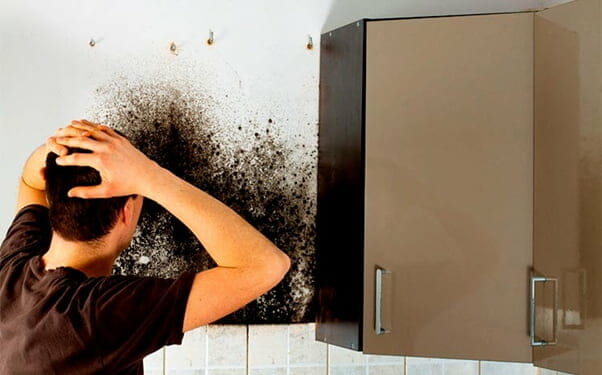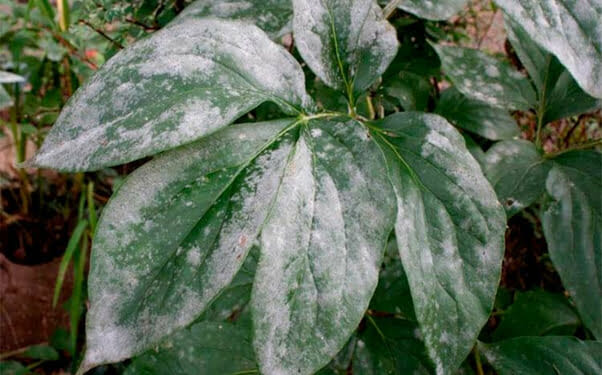Globally, more than 100,000 mold species exist. Though only a limited number of these species might appear in residential areas, it’s crucial to be vigilant about any mold presence in your home. However, what’s the situation with mildew? Does it classify the same as mold, and is it perceived as a dangerous presence?
Although the two terms are often used interchangeably, mold and mildew are not actually one and the same. Mildew is a certain type of mold, often found in bathrooms, laundries, and other areas where moisture levels are high. Mold refers to the entire family of fungi that grow in the form of multicellular hyphae.
Regardless, if you have mildew or any other type of mold growing in your home, you will need to take steps to have it removed immediately. There are no safe thresholds for any type of mold, and even small amounts of mold and mildew can prove injurious to your health in the long term.
Types of mold and mildew

With over 100,000 species in the mold family, it’s safe to say that you will very likely encounter several types of mold and mildew throughout the course of your life!
Some types of these fungi are more likely to be found in your home than others, depending on the conditions in your home. While it can be hard to visually distinguish among mold types, knowing some of the common characteristics of the most common molds can help your efforts to combat the growth of this fungus in your home.
It is important to note that some level of mold is likely always present in your home. It is when these levels reach a high enough level to result in a large, visible growth that will need to take action.
Common mold types
Although this list is by no means exhaustive, it does catalog some of the more common molds that might take root in your home.
- Aspergillus: This type of mold is very commonly found in households. With over 185 species of this type of mold alone, it can appear in a range of colors and textures. Aspergillus is known for its allergenic properties, causing significant reactions in those with mold allergies. It can also trigger severe respiratory issues, particularly in asthmatics.
- Chaetomium: This mold is typically found in homes and properties that have been water damaged. The texture is cottony, and it will change its color and appearance over time, morphing from white to grey to brown to black.
- Cladosporium: This olive-green to brown colored mold has a suede-like texture, and is most often found in fabrics, soft furnishings, and carpets. Cladosporium is also an allergenic mold and can cause a range of symptoms, including respiratory issues and rashes.
- Penicillium: Although this mold is perhaps best known for its use as an antibiotic in penicillin medication, the growth of penicillium can cause bad respiratory reactions when inhaled, especially in enclosed spaces. It is easily distinguishable by its distinctive blue-green color.
- Stachybotrys: This mold is the one that all homeowners dread – Stachybotrys is the official name of toxic black mold. Luckily, this species of mold is very unlikely to be growing in your home, as it requires a near-constant supply of moisture in order to take root. It can be identified by dark green or black color and slimy texture.
Common mildew types
Just as there are many species of mold, there are also many species of mildew. You are likely exposed to some level of mildew on a daily basis, and the very vast majority of this exposure is harmless.
There are some toxic types of mildew that you should make yourself familiar with, as these mildews can be damaging to your health if allowed to grow in large amounts.
- Basidiospores: Probably more familiar to most homeowners as dry rot, this type of mildew will grow on damp wood that has been left for a lengthy period of time without drying. If you encounter this type of mildew in the wild, it is often accompanied by growths of poisonous toadstools and mushrooms!
- Aureobasidium: This type of mildew is the type that is most commonly found in bathrooms and other places in the home where higher levels of moisture are present. This black mildew is relatively harmless unless you are exposed to it for long periods of time – nonetheless, remove it as soon as you can!
- Fusarium: This mildew grows in buildings and properties that have suffered water damage. Exposure to this type of mold can give rise to respiratory problems and symptoms such as a runny nose and red eyes.
- Botrytis: This type of mildew can be found on household plants. It is responsible for causing respiratory symptoms in susceptible persons and asthmatics.
How to identify mold vs mildew
As molds and mildews can grow in a variety of colors, textures, and appearances, it can sometimes be difficult to distinguish between these fungi with the naked eye.
The location of your mold or mildew growth can be a giveaway – most growths in bathrooms are usually mildew, for instance.
Many professional mold inspectors and remediators even have difficulty distinguishing between species of mold and mildew! If you find any fungal growths in your home or property, the best thing you can do is have them removed as soon as possible.
Mold vs mildew smell
One of the things that mold and mildew have in common is their distinctive, musty smell.
You are probably most familiar with the damp, musty smell that accompanies mold growth if you’ve ever left clothes in the washing machine for too long. The warm, moist environment of a washing machine drum is the perfect breeding ground for rapid mold and mildew growth and the nasty smell that goes along with it.
Interestingly, it is not the mold or mildew itself that gives off these smells, but rather gases that are emitted during the mold growth phase.
These gases are known as microbial volatile organic compounds (MVOCs). There are hundreds of different types of MVOCs, all of which typically have a very strong odor, and all of which can impact your health differently.
Excess exposure to MVOCs can cause the following symptoms, especially in susceptible persons.
- Nausea
- Headache
- Fatigue
- Runny nose
- Lightheadedness or dizziness
Which is worse, mold or mildew?
The United States Environmental Protection Agency (EPA) advises that there are no safe levels of mold or mildew growth inside your home. As such, any type of mold or mildew should be viewed as potentially hazardous and removed from your property as soon as possible.
While there are certainly some types of mold that have been demonstrated to be more dangerous to your health than others (toxic black mold comes to mind here!), you should never be lulled into a false sense of security about the presence of mold or mildew in your home.
Even though bathroom mildew might be common, it doesn’t mean you should allow it to grow unchecked. Even less dangerous species of mold and mildew can present a risk to your health if you are exposed to enough of them over an extended period of time.
What should I do if I find mildew?
It can be worrying to discover that mold and mildew are growing in your home, particularly if you are dealing with them for the first time.
Engaging the services of a professional mold remediator can provide you with peace of mind, and help you fix your mold or mildew problem quickly and efficiently.
Use this free service to fix your mold or mildew problem
HomeGardenGuides.com is a free service that quickly matches you with top-voted local Mold Inspection Specialists. These mold specialists can help identify whether you have mold or mildew growing in your home and provide friendly, professional advice on the best ways to remove it.
You can get 3 estimates fast by real, certified experts in your area in just 2 minutes by following the simple steps below.
- Scroll to the top of the page and enter your Zip code.
- Answer questions about your mold or mildew job.
- The details of your job will be forwarded to three local experts. They will send you a price estimate for the job and some friendly advice.
IMPORTANT: There is no obligation to hire. This is a free tool and service to be used at your pleasure.

Do mold and mildew grow in different places?
Both mold and mildew are part of the natural environment. They can grow anywhere, reproducing by means of tiny, lightweight spores that are carried through the air.
Both mold and mildew need similar conditions to grow – dark, damp, warmer spaces are ideal for the growth of these fungi.
Both mold and mildew can take root in your home when their spores land in a damp, moist environment. Although some particular conditions are more conducive to the growth of certain mold species (large amounts of moisture will usually cause stachybotrys to grow, for example), such concerns are irrelevant, as mold needs to be removed immediately, regardless of type of species.

How to get rid of mold and mildew
If you have mold or mildew growing in your home, there are a couple of things you will need to be aware of before you attempt to remove it.
Firstly, you should only ever perform home remediation on small patches of mold – less than 3 feet by 3 feet is the accepted size.
Secondly, if you do have a small patch of mold or mildew growing in your home, you should equip yourself with the proper personal protective equipment before attempting to remove this growth. The equipment you will need, at a minimum, includes:
- Mask (preferably N-95)
- Protective eyewear
- Rubber gloves
- Sturdy, enclosed shoes
Once you have the correct equipment, you will need to collect the necessary supplies for mold removal. Luckily, most small growths of household mold can be removed with a few products that you very likely already have lying around. Bleach, warm water, and some dishwashing detergent are all you need!
Removing mildew from your bathroom
If you need to remove mildew from your tiled bathroom, follow the below steps.
- Add 1 part bleach to 16 parts water.
- Apply the bleach-water solution to the mold-affected area with a sponge or cloth.
- Let the bleach-water solution sit on the affected area for at least 15 minutes.
- Scrub the affected area with a sponge or scourer if necessary.
Rinse the bleach-water solution off the tiled area with water and wipe dry. - Keep the area dry and well-ventilated.
Removing mold from drywall and concrete
Mold loves to grow on porous drywall and concrete. Try out the basic steps listed below to rid yourself of mold that might be growing on these surfaces.
- Add dishwashing detergent to a solution of bleach and water in the ratios of 1 part detergent, 10 parts bleach, and 20 parts water.
- Apply the solution to the affected area with a sponge or cloth. Do not over-saturate the surface.
- Allow the solution to air dry, and do not rinse away the detergent-bleach-water solution.
- Keep the area dry and well-ventilated.
How do I prevent mold and mildew from returning?
It can be extremely frustrating to spend time and effort in removing mold and mildew, only for it to grow back.
The best and most surefire way of keeping your home free of mold and mildew in the long term is to keep your home as dry and moisture-free as possible. This of course includes obvious fixes such as mending leaking pipes and loose roof tiles but may also require a bit more of a concerted effort, especially if you live in a particularly humid climate.
Dehumidifiers can provide great help in preventing mold spores from finding a hospitable home on your property, as can plenty of sunlight and proper ventilation.
The best way to prevent mold growth is to remain vigilant against it – clean up any spills or leaks as soon as they occur, and regularly dust down surfaces in your home to prevent those pesky mold spores from taking root!
What causes mold growth?
Mold grows in damp, moist environments in which mold spores have spread and are able to take root. Mold spores are everywhere in nature, both indoors and outdoors (you’re probably breathing some in right now!), so it is impossible to completely eradicate all traces of mold from your home environment.
By controlling moisture levels in your home, and keeping it well-ventilated, you may be able to stop most mold growths before they can take up residence. Mold can not grow without moisture and dampness, so keeping your property dry is the best way to keep mold growths at bay!







